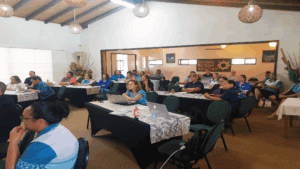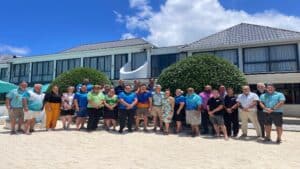As the Cook Islands reflects on 60 years of nationhood, Cook Islands Investment Corporation’s journey is also a reminder that strong institutions are the scaffolding of effective governance.
This year, the Cook Islands celebrate a milestone few small island nations can claim: 60 years of self-governance in free association with New Zealand.
A vibrant archipelago of 15 islands scattered across the South Pacific, the Cook Islands has, since 1965, carved out a unique political and cultural identity, balancing traditional values with modern governance, and autonomy with enduring ties to its former colonial partner.
The path to self-governance was neither sudden nor simple.
Under New Zealand administration since 1901, the Cook Islands gradually built the institutions and capacity to manage its own affairs.
A critical step came with the adoption of a written Constitution on 4 August 1965, following a referendum that saw the local population vote in favour of self-governance in free association with New Zealand.
Albert Henry, the first Prime Minister of the Cook Islands, is widely regarded as the godfather of modern Cook Islands politics, a towering figure whose leadership helped define the early path of the new nation.
Elected in 1965, Henry was a charismatic and visionary leader who sought to blend modern political structures with cultural tradition, including through the creation of the House of Ariki.
He was an advocate for regionalism and was instrumental in the establishment of the Pacific Islands Forum of which the Cook Islands was one of 7 founding nations.
He championed unity, development, and greater autonomy, laying many of the foundations of modern governance.
As the Cook Islands commemorates this important milestone, it’s not just the political journey that deserves recognition, but also the evolution of institutions that have shaped its economic and infrastructural foundation.
Among these, the Cook Islands Investment Corporation (CIIC) stands out as a transformative force.
Formed in the late 1990s, CIIC emerged out of a pressing need to reform how public assets and State-Owned Enterprises (SOEs) were managed.
For the first three decades of self-governance, the management of government buildings, land, and enterprises remained heavily embedded within the machinery of government, often leading to inefficiencies and overlapping responsibilities.
Brian Mason, a key figure in CIIC’s formation and current chair of To Tatou Vai, reflects: “CIIC was the Government’s solution to separating the asset management side of Government and pulling together all State-Owned Enterprises under one umbrella. The goal was to ensure they were better coordinated, and slightly removed from Government, to undertake their core functions more effectively.”
“The economic reform in 1996 arose in part out of an unsustainable bloated public service where excess staff were employed at the expense of the maintenance of infrastructure which was seriously neglected. The solution was to remove the politics from statutory corporations and trap their profits within an organisation that would use those funds to maintain Crown assets for the benefit of the public. Many believe the establishment of the Corporation in 1998 was a condition of the New Zealand Government’s assistance to the Cook Islands at the time. They are wrong. There was no such precondition and the primary architect and driver of the establishment of the Cook Islands Investment Corporation was former Prime Minister, the late Sir Geoffrey.”
The creation of CIIC marked a bold shift to a corporate-style governance model: one that introduced greater accountability, transparency, and commercial discipline to public asset management, without losing sight of national development priorities.
Today, CIIC oversees everything from government land, buildings and infrastructure projects to strategic entities such as the Airport and Ports Authorities – critical arteries for the country’s economy and connectivity.
Deputy Prime Minister and Minister responsible for CIIC, the Honourable Albert Nicholas says the early years of CIIC were formative years.
CIIC didn’t group itself properly until the current Prime Minister Mark Brown became the Minister of CIIC. The baton was handed to him, he says to carry through with that momentum.
“CIIC has had a lot to do in the Crown land management space, addressing a lot of land matters that had not been dealt with properly in the past. While a lot has been done, there is a lot more to do,” Mr Nicholas says.
“It is about the Crown/Government, working hand in hand with landowners.”
CIIC Chairperson Fletcher Melvin describes the agency’s role as not merely administrative, but strategic.
“By consolidating asset and enterprise oversight, CIIC has brought consistency and long-term planning to areas once hampered by short-term political cycles.”
Over the past two decades, CIIC has helped move the nation from reactive governance to proactive investment in infrastructure.
It has delivered projects that embody not only economic value, but national pride – upgrading schools, hospitals, and government offices, and ensuring these assets are fit for purpose and future generations.
Capacity building is another key focus, with an emphasis on developing local professionals to manage national assets with skill and integrity.
In a small nation like the Cook Islands, where human capital is precious, this investment is vital.
The CIIC Group achievements since its inception are many.
They include developing effective corporate governance protocols for its entities, delivering best practice Directorship training programmes, various infrastructure upgrades like Tereora College, the new Mental Health Unit at Rarotonga Hospital, the Avatiu Wharf Redevelopment, the Manatua Fibre Optic Cable, better facility management programmes, sorting out various historic land matters, and most recently the unqualified audit opinion of Crown assets.
CIIC as a group has been marking the country’s 60th anniversary since the start of the year.
The Airport Authority Cook Islands kicked off celebrations by walking the airport runway in January.
Three CIIC entities are also Ariki sponsors – the Bank of the Cook Islands, Te Aponga Uira and Vodafone.
To mark the 60th anniversary of self-government, CIIC will also roll out a number of activities including:
– A video series, featuring CIIC’s own cartoon character KATO, to explain the Corporation’s role and vision
– A retrospective video on sports infrastructure celebrating 60 years of investment, and looking to the future
– A video series profiling vendors at the Punanga Nui Market
As the country reflects on 60 years of nationhood, CIIC’s journey is a reminder that strong institutions are the scaffolding of effective governance.
Though it joined the stage three decades into the nation’s self-rule, it has become an indispensable player in the story of modern Cook Islands development.
Looking ahead, CIIC’s ongoing evolution reflects a national commitment to resilience, sustainability, and sovereignty.
It embodies the spirit of self-governance—not just in name, but in action.
“Self-governance was a statement of ownership,” says Prime Minister Mark Brown. “And over the years, we have shown that with partnership, vision, and the strength of our people, we can thrive and define our own future.”
The 60th anniversary theme—Kua kite au i toku turanga, e Avaiki toku / I know who I am, I have a homeland—is not only a time for celebration, but also reflection and renewal.



